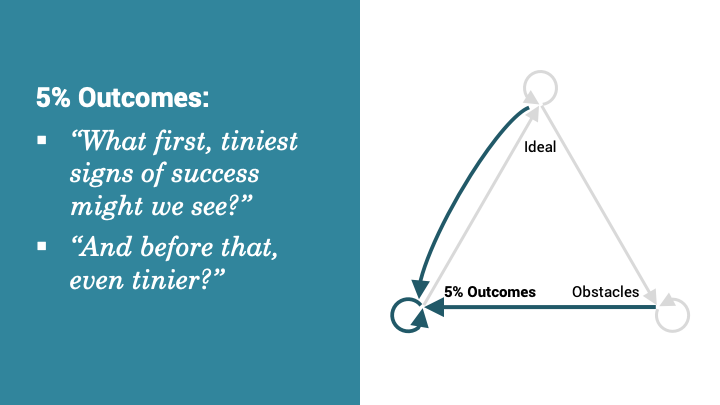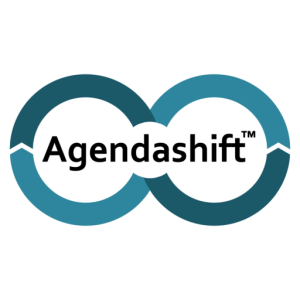In chapter 1 of Agendashift (2nd edition 2021) you’ll find a crucial but awkwardly-named exercise, Practice Outcomes. It’s there because the main event, the Clean Language-inspired coaching game 15-minute FOTO, goes so much better if players have been primed to start small. If your first outcome is a small one, the chain of consequences that follows – “Then what happens? Then what happens?” – is so much more productive.
5% outcomes, getting unstuck
I’ve been working on making not just the exercise of Practice Outcomes but its outputs and its rationale easier to reference. Hence “5% outcomes”, the kind of teeny-tiny outcomes you get from the miracle question (source: Solutions-focused brief therapy, via the 2006 Jackson and McKergow book The Solutions Focus). The version of the miracle question we use in Practice Outcomes isn’t exactly canonical but it’s close enough:
- If that obstacle disappeared overnight (it doesn’t matter how), what would be the first thing you would notice? (something positive)
The rationale? Make your outcomes small enough, and perhaps they’re there already if only you knew where to look. And if they’re there, so are what causes them – solutions! A great way to get unstuck.
If you find yourself not wanting to explain the miracle question, something simpler:
- What first, tiniest signs of success might we see?
- And before that, even tinier?
Context for those questions might be a some kind of obstacle, an outcome (a larger one, obviously), or even our overall objective. Here I’ve visualised it in terms of the IdOO (“I do”) pattern:

15% outcomes, getting going
If we get unstuck with 5% outcomes and their corresponding 5% solutions, then 15% outcomes and their corresponding 15% solutions are how we make faster progress. I’m riffing on the Liberating Structures pattern 15% Solutions, whose rationale speaks to the stuckness issue but invites us to think a little bigger. If our attitude is that “15% is always there for the taking”, then we’re primed to iterate towards our goals. Faced with an adaptive challenge, the sooner we embrace that kind of approach, the better. Here, 100% solution are worse than unlikely, they’re a route to failure.
15% is always there for the taking
15% Solutions: Discover and Focus on What Each Person Has the Freedom and Resources to Do Now (liberatingstructures.com)
The questions here:
- “How will we know that we’ve made a small but significant step in the right direction?”
- “And then what happens?”
Anticipating one of the three most important questions in 15-minute FOTO, the “And then what happens?” is already getting us to think more iteratively. Visualised:

5% and 15% outcomes, yes outcomes
You might be wondering why I start with Solutions Focus and 15% Solutions and invite participants to capture not solutions but outcomes. Is this some strange insult to my sources? Not a bit of it!
Think of Agendashift as a two-pronged approach to adaptive strategy:
- its formation through an ongoing process of meaningful participation
- integrated with innovation and learning processes
In the context of an adaptive challenge in a changing environment (one we’re actively changing, no less), if we take the attitude that solutions are always there for the taking – a core premise of both our sources – the right time for solutions is just in time. To solutionise sooner is to invite solutions that may be beyond their shelf life by the time they’re really needed. Worse, having them designed only by the people who happen to be in the room at the time is another recipe for failure.
We are not merely counting on but institutionalising the emergence of solutions “from the people closest to the problem”, to quote my friend Karl Scotland. Keeping that innovation process well fed, appropriately oriented, and with room to breathe, strategy is developed in the language of outcomes.
Going as far as mostly as avoiding the term change management for fear of being associated with it, this is the very antithesis of 1990’s-style managed change. Great for upgrading your email server, but completely the wrong paradigm for anything transformational. Catch yourself thinking that a preconceived solution – worse, a borrowed one – should be your main response to your adaptive challenge? Tempting, but think again. You’d be making a category error, already a terrible place to start. Rolling it out, overcoming resistance to change and all that? Well that would be doubling down, compounding the mistake, and the consequences will be yours to own.
So solutions come well after outcomes, not before. But if you hear a solution prematurely – even a 5% or 15% solution – don’t worry. They’re easy to deal with:
- Then what happens?
Get unstuck and get going with 5% and 15% outcomes. Small – tiny even – but powerful!
What if we put agreement on outcomes ahead of solutions?
Agendashift™: Serving the transforming organisation
Agendashift Academy: Leading with Outcomes | Home | Store
Links: Home | Subscribe | Become an Agendashift partner | Events | Contact | Mike
Resources: Tools & Materials | Media | Books | Assessments
Blog: Monthly roundups | Classic posts
Community: Slack | LinkedIn group | Twitter
